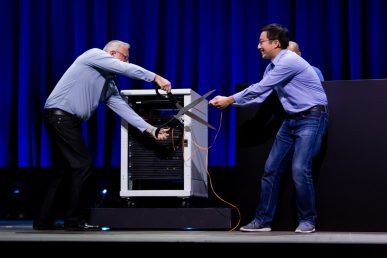Ifat Afek can’t freeze time, but she knows how to make the most of it.
On top of her job as a system architect at Nokia, Afek has taken an active role in the OpenStack community as the project team lead (PTL) of Vitrage and a voice in gender equality in the technology field with the Women of OpenStack. You may have also seen her taking center stage at the recent OpenStack Summit Barcelona, where she took part in a daredevil demo.
Afek talks about her role in the OpenStack community, how you can have a more visible role in OpenStack and bringing open source to new audiences.
Words to live by — What are yours?
Try to enjoy what you are doing – life will be a lot easier this way.
If you could be a superhero, what would your superpowers be?
I’d like to have the power to stop the clock once in a while. This way I’ll be able to finish all my tasks at work, spend more time with my family, and I’ll have enough time left to just sit by the beach and watch the ocean 🙂
How did you become a PTL?
Prior to the Vitrage project, I was working on a root cause analysis engine as part of the Nokia CloudBand solution. I took the PTL role when the Vitrage development started, right after the Tokyo summit.
There are always a lot of debates in the OpenStack community – which one is the most important, now?
I’ll refer to a past debate, about whether or not to split the OpenStack summit into two – a main summit and a Design Summit. After very long discussions and debates it was decided to split the summit into two parts. Personally, I think there were a lot of advantages in having one shared Summit for all.
Finish the sentence: OpenStack is great for _____
OpenStack is great for people who want to make a difference. As an open source contributor, you are free to enter whatever project you are interested in, learn how it works and start contributing. If you are doing a good job, you’ll be appreciated. And the collaboration with other contributors and companies makes it even more interesting.
OpenStack is bad for people who will not _____
OpenStack is bad for people who don’t play by the rules. In order to work as a community, we should all follow some ground rules. When contributors want to enter a new project, they should first understand how it is being developed and what the best practices are. Otherwise, they’ll have a hard time getting their ideas approved.
Why do you think it’s important for women to get involved with OpenStack?
I think women should be involved in everything 🙂
And seriously – why not? Did someone ever ask why men should be involved in OpenStack? The same answer should apply for both. I think it’s a shame that only about 10 percent of OpenStack contributors are women, I wish there were a lot more.
What obstacles do you think women face when getting involved in the OpenStack community?
I think these are the same obstacles that men are facing when trying to get involved in OpenStack. It’s not so easy to get started.
You spoke on stage at the Barcelona Summit and are also a PTL – what advice do you have for people who want to take leadership or more visible role in OpenStack?
Just go ahead and do that! Find interesting projects, talk to their leaders and see where you can contribute. One thing can lead to another and step by step you can gain more visibility and recognition.
As an example, I’m trying to get involved in other related projects. One of them is the OPNFV Doctor project for fault management. Doctor and Vitrage presented a few common sessions in the past, and in the OPNFV Summit in Berlin there was a booth with two POCs running side by side – Vitrage as Doctor Inspector, and Congress as Doctor Inspector. The result of these demos was that we were invited to present a shared demo in the OpenStack keynotes.
OpenStack has been called a lifelong learning project for those involved- how do you stay on top of things and/or learn more?
All the information is out there, one just needs to go and check. I’m doing my best to stay up to date with all the latest changes and discussions. I constantly follow the OpenStack mailing list and check what is pushed to Gerrit in some projects I’m interested in.
This post is part of the Women of OpenStack series to spotlighting the women in various roles in our community who have helped make OpenStack successful. With each post, we learn more about each woman’s involvement in the community and how they see the future of OpenStack taking shape. If you’re interested in being featured, please email [email protected].
Cover Photo // CC BY NC
- Fighting for usability in the open source community - February 20, 2017
- How to take a leadership role in OpenStack - December 22, 2016
- OpenStack Community Contributor Awards recognize unsung heroes - October 28, 2016

)










